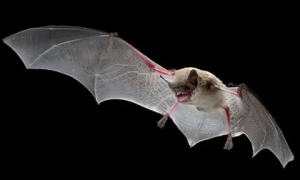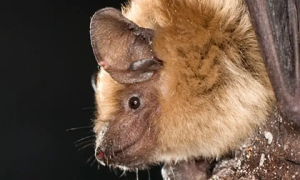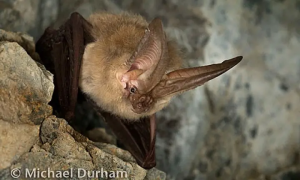
Native Bats of the Clackamas
Oregon’s native bats are hard at work protecting our local ecosystem. Here in the Clackamas Watershed, several species help keep insect populations in check and contribute to the region’s biodiversity.
Oregon has 15 native bat species (no known invasive bats) but not all of them are found in the Clackamas watershed. Let’s take a closer look at some of the bats you might find in the Clackamas watershed, dispel a few myths about these often-misunderstood creatures, and learn how we can all help protect them.
Meet Oregon’s Native Bats
1. California Myotis (Myotis californicus)

This small bat is commonly found in forests, open woodlands, and even near bodies of water in the Clackamas River area. The California myotis is known for its agility in flight and its preference for catching flying insects like moths and mosquitoes. This bat is an Oregon Conservation Strategy Species. Some things impacting their populations are low reproductive rates and lack of large snags (dead trees) for day roosting. Image: ODFW, Michael Durham
2. Long-eared Myotis (Myotis evotis)

As its name suggests, the long-eared myotis is easily recognizable by its large ears, which help it locate insects on the ground and in foliage. This bat is often found in forests and shrublands, where it feasts on beetles and other insects that hide in vegetation. This slow flier can sometimes enter buildings looks for tasty moths. Image: ODFW, Michael Durham
3. Little Brown Myotis (Myotis lucifugus)

One of the most widespread bats in Oregon, the little brown myotis thrives in a variety of habitats, from riparian areas to dense forests. This species is especially important for pest control, consuming vast amounts of mosquitoes and agricultural pests. Unfortunately, it faces threats from diseases like white-nose syndrome, making conservation efforts even more critical. Image: ODFW, Michael Durham
4. Yuma Myotis (Myotis yumanensis)

The Yuma myotis loves water! Found near rivers, lakes, and ponds, this bat often roosts in caves, trees, or even human structures like barns. It’s a key insect-eater in the Clackamas Watershed, often hunting over water for aquatic insects like midges and caddisflies. This bat migrates in the fall to southern locations. Image: ODFW, Michael Durham
5. Hoary Bat (Lasiurus cinereus)

The hoary bat is one of Oregon’s largest and most striking species, with a fur coat that appears frosted or “hoary.” These solitary bats are migratory and spend their summers in Oregon’s forests, including areas along the Clackamas River. They prefer open spaces for foraging and feed on moths, beetles, and other flying insects. You may see them eating insects around your outdoor lights. The Hoary bat is an Oregon Conservation Strategy Species. Typically, this bat will have twins! Image: ODFW, Michael Durham
6. Big Brown Bat (Eptesicus fuscus)

True to its name, the big brown bat is one of the larger species in Oregon. It’s often seen flying at dusk in urban and rural areas, hunting for beetles, flies, and other night-flying insects. This bat roosts in a variety of places, including hollow trees, rock crevices, and attics. They are more active in the winter than other bats. Image: ODFW
7. Townsend’s Big-eared Bat (Corynorhinus townsendii)

With its distinctively large ears and preference for caves and abandoned structures, Townsend’s big-eared bat is a fascinating species. This bat feeds primarily on moths and is particularly sensitive to human disturbance in its roosting habitats, making it an Oregon Conservation Strategy Species. Image: ODFW, Michael Durham
8 – 15. Other bats of Oregon
Here are the other native bats of Oregon that we did not talk about because they live in other parts of the state: Western small-footed myotis, Fringed myotis, Long-legged myotis, Silver-haired bat, and the Canyon bat.
Dispelling Myths About Bats
Despite their ecological importance, bats are often misunderstood. Let’s clear up a few common misconceptions:
- Myth 1: Bats are aggressive and will attack people.
Truth: Bats are generally shy and avoid human interaction. If you see a bat flying near you, it’s likely chasing insects, not trying to get close to you. - Myth 2: All bats carry rabies.
Truth: While bats can carry rabies, only a small percentage are actually infected. As with any wild animal, it’s important to avoid handling bats and call wildlife professionals if you find an injured or sick one. - Myth 3: Bats are pests.
Truth: Bats are natural pest controllers! A single bat can consume thousands of insects in just one night, helping to reduce the need for chemical pesticides.
How You Can Help Protect Bats in the Clackamas Watershed
Bats face many threats, from habitat loss and pesticide use to disease and human disturbance. Here are some ways you can help:
- Install a Bat House: Provide a safe, warm place for bats to roost by installing a bat house on your property. This helps bats find secure shelter and gives them a place to raise their young.
- You can use this bat house guide: Small Economy Bat House
- Reduce Pesticide Use: By limiting the use of pesticides in your yard, you can help protect the insects that bats rely on for food. This also benefits pollinators like bees and butterflies.
- Protect Natural Habitats: Bats need healthy forests and riparian areas to thrive. Support local conservation efforts aimed at preserving and restoring these vital habitats along the Clackamas River.
- Turn Off Unnecessary Lights: Bright lights can disrupt bats’ natural foraging and migration patterns. Try to minimize outdoor lighting at night, especially during bat feeding times.
- Educate Others: Help spread the word about the importance of bats in our ecosystem. Share facts and dispel myths so that others can appreciate these fascinating creatures.
- Leave snags: Dead trees can provide roosting habitat for bats. They also attract beetles and other insects that bats like to eat.
Conclusion
The native bats of the Clackamas Watershed play an essential role in maintaining a healthy, balanced ecosystem. From controlling insect populations to pollinating plants, bats provide numerous benefits to our environment. By learning more about the bats that call this region home and taking steps to protect them, we can ensure that these amazing creatures continue to thrive for generations to come.
Next time you’re near the Clackamas River at dusk, take a moment to appreciate the unseen world of bats overhead—you just might spot one of these incredible species in action!
Stay tuned for more updates on wildlife and conservation efforts in the Clackamas River Basin!